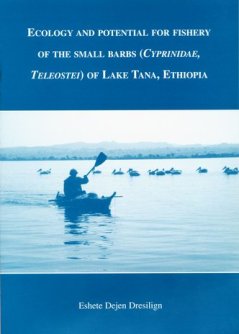Ecology and potential for fishery of the small barbs (cyprinidae, teleostei) of Lake Tana, Ethopia
Lake Tana is by far the largest lake of Ethiopia and source of the Blue Nile. By feeding on zooplankton, small barbs (< 10 cm) occupy a central position in Lake Tana’s ecosystem. Catching them could release pressure on the overexploited, unique species flock of large barbs (up to 100 cm). Aiming at small barbs, we need first to assess its possible impact on the food web and productivity. To advise on sustainable management, the biology and ecology of the small Barbus species in Lake Tana was investigated: identification, feeding biology and major food source (i.e. zooplankton) in the environment, their reproductive biology, individual growth and productivity. Three valid small Barbus species (Barbus humilis, B. pleurogramma and B. tanapelagius) were identified in Lake Tana. Barbus tanapelagius is discovered in this study and it is endemic to Lake Tana. Barbus humilis and B. tanapelagius are the most abundant small barbs and will have a central role in energy and biomass transfer in the food web of the lake.

Resource partitioning with competitors (juveniles of the large barbs and a zooplanktivorous larger barb, Barbus brevicephalus) involve space and food. Habitat use differed along the littoral-pelagic gradient. Barbus pleurogramma, B. humilis and juvenile ‘large barbs’ preferred the littoral shallow habitats, whereas B. tanapelagius and B. brevicephalus predominantly occupied sublittoral and pelagic habitats. This high degree of habitat segregation between the juveniles of the commercially important ‘large barbs’ and the ‘small barb’ B. tanapelagius opens perspectives for a subsidiary small-meshed fishery for small barbs in the pelagic habitat.
The information generated in this study pertaining to the resource partitioning, interaction between small barbs and juvenile large barbs, reproduction, growth, mortality and the production of small barbs is used to discuss the potential to start subsidiary small-meshed fishery on the small barbs and its consequences on the existing fishery and fish community. The annual maximum sustainable yield of B. tanapelagius was 4,000 ton (fourfold of the current annual fish catch from the lake). Recommendations to start subsidiary small-meshed fishery only for B. tanapelagius at the pelagic habitat based on the annual maximum sustainable yield and production potential (annual P/B ratio) is given.